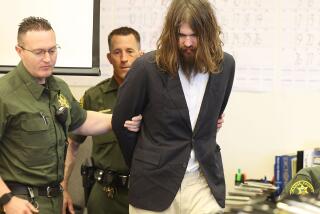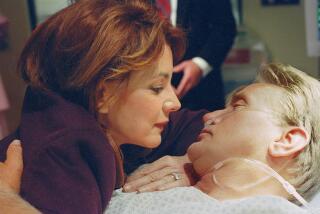TV REVIEWS : PBS’ ‘Oswald’ a Riveting ‘Frontline’
- Share via
Of course there’s no hard evidence, the supporters of various Kennedy assassination theories have often argued. That’s how brilliant the conspirators were.
Or, as Oliver Stone’s Jim Garrison says in “JFK,” “White is black and black is white.” The truth, the theorists say, lies in the shadows of the murky web of connections surrounding J.F.K.’s killing. The available evidence is a mere distraction, part of the cover-up.
Time and technology, though, are catching up with the theorists, and the answers to the key questions behind the Nov. 23, 1963, assassination are beginning to emerge. The investigative team assembled by “Frontline” to produce the magnetic three-hour “Who Was Lee Harvey Oswald?” (at 9 tonight on KCET-TV Channel 28 and KPBS-TV Channel 15; 8 p.m. on KVCR-TV Channel 24) is the first to take advantage of several new factors aiding assassination snoops.
Consider the following. KGB agents and staff can talk now as they never could before to explain not only Oswald’s previously mysterious defection to the Soviet Union and his return to the United States, but also his later attempts to defect to Cuba. Only recently have CIA files on Oswald become available, as well as the Warren Commission files that Stone and others campaigned to be made public. Previously silent eyewitnesses and contacts to Oswald are coming forward. Computer graphics and image enhancement allow more detailed and convincing study of film and forensic evidence.
But producers William Cran and Ben Loeterman are after bigger game than just more evidential shreds that will blow the case wide open. What they’ve done is the nonfiction companion for Don Delillo’s brilliant novel on Oswald’s life and mind, “Libra.” They’ve doggedly tracked Oswald’s twisted life and, in the process, presented a failed man determined to make himself into a significant political force.
Oswald’s entire life, as byzantine as it gets in this amazingly complex telling, shows a simple, consistent pattern of disappointment. Even his one seeming success--his marriage to Marina, whom he met in the USSR--dissolved into bitterness, yelling and beatings. Every witness quoted here, no matter the location or circumstances, describes a frustrated young man, a loner, a loser.
Oswald could be amazingly cool under fire, as was shown in a radio debate he held with Castro opponents or in his post-assassination interrogation, but he never drew people to him. The Oswald here is a dilettante in various political realms, from his contacts with Japanese radicals during his Marine stint in Japan, to his possible attempts to infiltrate anti-Castro groups.
What appears very unlikely is that he was ever at the bidding of either the CIA, KGB or the Mafia. Even House Select Committee on Assassinations chief counsel G. Robert Blakely admits that as much as he believes that the Mafia was behind Kennedy’s murder, there’s not enough evidence to take to court. And the “Frontline” team pieces together hard evidence showing that Oswald really did pull the trigger of the gun that shot Kennedy.
It also skips over other evidence suggesting additional bullets at the assassination site (meaning additional gunmen), and can’t detail key days in which Oswald may or may not have made contacts with underworld figures and other potential Kennedy enemies. But its conclusion in favor of a lone gunman theory rests on so much more than the discredited Warren Commission report that conspiracy hunters may have second thoughts. White, after all, may be white.
More to Read
The complete guide to home viewing
Get Screen Gab for everything about the TV shows and streaming movies everyone’s talking about.
You may occasionally receive promotional content from the Los Angeles Times.






